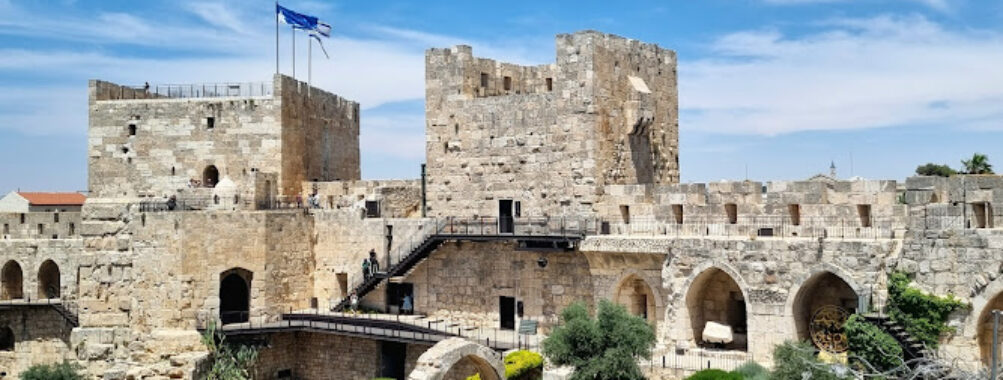
Tower of David
“`html
Table of Contents
Description
The Tower of David is one of those places that truly makes you stop and think about time. Standing at the entrance to Jerusalem’s Old City, this medieval citadel has been a silent witness to more than 2,000 years of history. Empires rose and fell around it, armies marched through its gates, and yet here it still stands, layered with stories. Inside, you’ll find the Museum of the History of Jerusalem, which does a surprisingly good job of weaving together the city’s complicated past without overwhelming you with dry facts. The exhibitions are interactive, the audio guide is easy to follow, and the space itself has this atmospheric charm that makes you feel like you’re stepping back in time.
What I personally love about the Tower of David is that it’s not just about looking at old stones (though the stones are impressive). It’s about the way the place connects you to the living, breathing story of Jerusalem. You can see live performances in the courtyard, wander through ancient towers, and even catch the famous night light show that projects the city’s history across the stone walls. Sure, not every visitor falls in love with it—some find it crowded or expect more “traditional” museum displays—but for most, it’s an unforgettable stop. And honestly, even if you’re not a history buff, the views alone from the ramparts are worth the ticket.
Key Features
- Medieval citadel built on the remains of ancient fortifications dating back over 2,000 years
- Comprehensive Museum of the History of Jerusalem with interactive exhibits
- Famous night light show projected on the citadel walls
- Live performances and cultural events in the courtyard
- Audio guide available for an immersive experience
- Wheelchair accessible entrance, restrooms, and seating
- Family-friendly with activities suitable for children
- Restroom facilities on-site (though no restaurant inside)
- Assistive hearing loop and assisted listening devices available
Best Time to Visit
Jerusalem’s seasons make a big difference when planning your visit. Spring (March to May) and autumn (September to November) are the sweet spots—mild weather, clear skies, and fewer chances of being roasted under the summer sun. Winter can be chilly and rainy, but there’s a certain moody magic in seeing the citadel under grey skies. Summer, on the other hand, can be uncomfortably hot, especially in the middle of the day, so if that’s your only option, go early morning or late afternoon.
If you can, time your visit around sunset. Watching the golden light hit the Old City walls is one of those moments you’ll carry with you long after your trip. And if you’re a night owl, the evening light show is an absolute must—it transforms the citadel into a canvas of sound and color. Just keep in mind that this is a popular spot, so weekends and holidays can get crowded. If you prefer a quieter experience, aim for a weekday morning.
How to Get There
The Tower of David sits right by the Jaffa Gate, which is one of the main entrances to Jerusalem’s Old City. If you’re staying nearby, walking is the easiest and most enjoyable way to get there—you’ll weave through lively streets, pass market stalls, and suddenly find yourself face-to-face with the citadel. For those coming from further out, buses and the light rail connect well to the area, though you’ll likely need to walk a short stretch. Taxis and rideshares are also an option, but traffic around the Old City can be unpredictable, so give yourself extra time.
Driving is possible, but parking is limited and often stressful. Honestly, unless you’re very comfortable navigating Jerusalem’s streets, it’s better to leave the car behind. The Old City is best experienced on foot anyway, and the Tower of David is right at the gate, so you won’t have to wander far.
Tips for Visiting
First piece of advice: book your tickets in advance. It saves you from waiting in line and guarantees your spot, especially if you’re planning to see the light show. Once inside, take your time. Don’t rush through the exhibits—there’s a lot to absorb, and the museum is designed to guide you through Jerusalem’s history in a way that feels like a journey rather than a lecture.
If you’re traveling with kids, good news: the museum is surprisingly engaging for younger visitors. There are interactive elements, and the open courtyards give them space to move around. Just bring some snacks and water since there’s no restaurant on-site.
Accessibility is thoughtfully considered here, with wheelchair-friendly entrances, restrooms, and seating. Still, some parts of the citadel involve stairs and uneven stone paths, so plan ahead if mobility is an issue.
Another tip: bring a hat and sunscreen if you’re visiting during the day. The Jerusalem sun doesn’t mess around, and shade can be scarce in certain areas. On the flip side, evenings can get chilly, especially in the winter months, so a light jacket is a good idea.
Lastly, don’t forget to climb up to the viewing points. From the top, you’ll get sweeping views of the Old City and beyond—it’s one of the best panoramas in Jerusalem. And honestly, it’s those views, combined with the layers of history beneath your feet, that make the Tower of David such a special place to visit.
“`
Location
Places to Stay Near Tower of David
Find and Book a Tour
Explore More Travel Guides
No reviews found! Be the first to review!